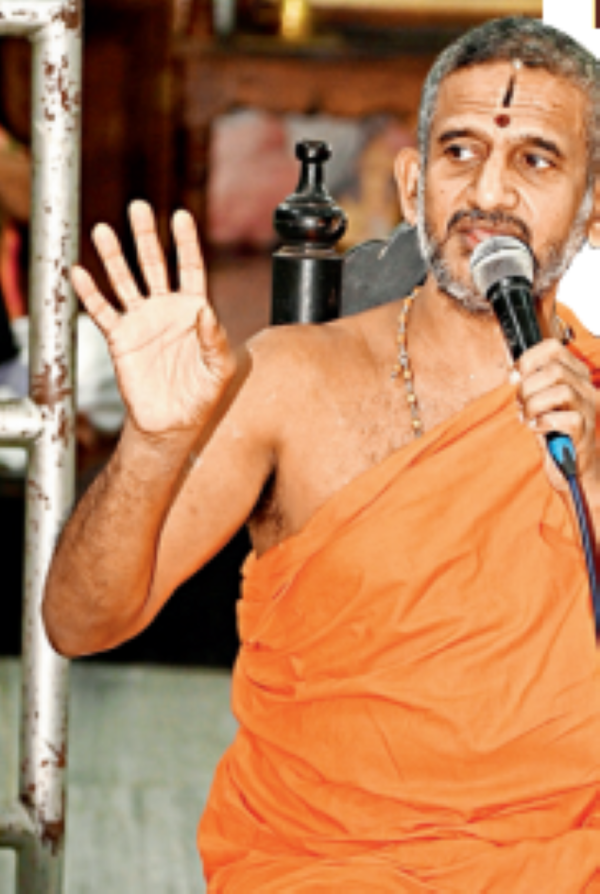Karnataka is playing a crucial role in the construction of the Ram Lalla temple in Ayodhya. Several key figures from the state, such as Pejawar Mutt seer Sri Vishwaprasanna Thirtha Swamiji and Mysuru sculptor Arun Yogiraj, are actively involved in this monumental project.
The Ayodhya Ram temple, known for its massive scale and collective efforts of thousands, has seen significant contributions from Karnataka. Notably, at least three key individuals overseeing various aspects of the temple construction hail from the state, and the very foundation of the temple is sourced from Karnataka
Pejawar seer Vishwaprasanna Thirtha Swami
Pejawar seer Vishwaprasanna Thirtha, the sole seer from South India in the 15-member Sri Rama Janmabhoomi Trust overseeing the construction of Ayodhya Ram Mandir, has assumed a prominent role in consecration of the Ram Lalla statue scheduled for January 22. Since joining the trust two years ago, the seer has diligently travelled between Udupi and Ayodhya to supervise the temple’s construction

Sadahalli marble, agarbattis, silver bricks and gold chains
In addition to the prominent figures overseeing the construction and consecration of Ayodhya Ram Mandir, a significant quantity of materials has been sourced from Karnataka. Notably, Sadahalli Marble, extracted near Kempegowda International Airport in Devanahalli, has played a substantial role. VHP state functionaries estimate that an impressive 700 to 800 tonnes of this marble have been transported to Ayodhya for the project. Furthermore, Karnataka has contributed 150 kilograms of agarbatti, silver bricks, and even gold chains, intended to adorn the Ram Lalla idol in Ayodhya
Gopal Nagarkatte, VHP national joint secretary
Vishwa Hindu Parishad, which has been at the forefront of the Ayodhya Ram Mandir construction, is actively involved in the process. Gopal Nagarkatte, hailing from Bengaluru and currently VHP national joint secretary, has been entrusted with full authority for overseeing the construction. Formerly a regional pracharak of Rashtriya Swayamsevak Sangh and an alumnus of Gulbarga University, Nagarkatte has played a prominent role in the temple’s development
The Anjanadri Betta connection…
Ayodhya Ram Mandir, designed to reflect the birthplace of Lord Rama, has inspired Karnataka to consider a similar approach for the development of Anjanadri Hills — birthplace of Hanuman, a devoted follower of Lord Ram. Claims suggest that the stones used for the Ayodhya installation were sourced from Anjanadri, establishing a symbolic connection. The hills are currently seeing a substantial increase in the number of tourists, particularly from North India, coinciding with the consecration of the Ayodhya temple. In its preceding budget, the Karnataka government earmarked Rs 100 crore for the development of Anjanadri Hills, mirroring the blueprint of the Ayodhya Ram Mandir
Arun Yogiraj, Mysuru sculptor
The 40-year-old Mysuru based fifth-generation sculptor, Arun Yogiraj, known for his expertise in crafting monumental works such as the 30-foot idol of Netaji Subash Chandra Bose at Amar Jawan Jyothi behind India Gate and the statue of Adi Shankaracharya in Kedarnath, has sculpted an idol. Sources said this idol is almost finalised for the consecration at Ayodhya Ram Mandir. Arun’s family has a rich legacy in sculpting, with his father, Yogiraj, and his grandfather, Basavanna Shilpi, both being acclaimed artists. Basavanna Shilpi received patronage from the former kings of Mysore.
